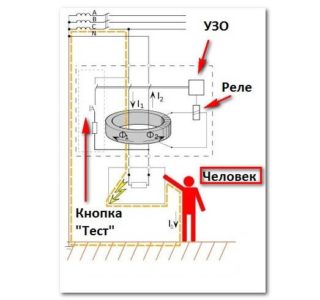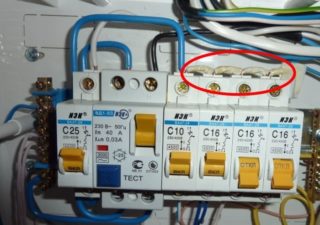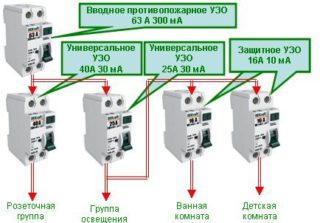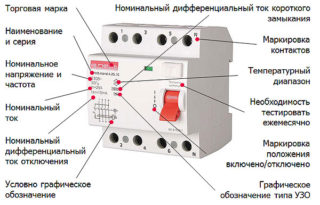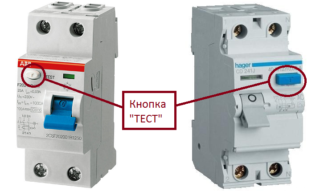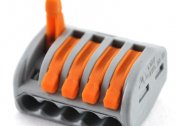A residual current device or RCD is a device used in electrical circuits to protect workers and household consumers from electric shock. Its installation is possible not only in single-phase circuits, but also in three-phase current supply lines, which are often operated in country houses. For a deeper understanding of the features of the functioning of the device, you will need to understand its purpose, the principle of operation, as well as all the intricacies of installation within the facility.
Principle of operation
When you get acquainted with an RCD machine, the most important thing is to understand the principle of its protective action. It is important to note the following:
- the design of the device provides a differential module that fixes the difference between the values of the inflowing and outflowing currents;
- when it is detected, it sends a signal to the executive unit, opening the power supply contacts;
- since an automatic device is installed immediately after the electric meter (to the distribution machine), when it is triggered, the power supply circuit of the object instantly turns off.
The principle of operation of an RCD in a single-phase network lies in its ability to respond to the slightest current leakage that occurs in emergency situations (in the case of insulation failure, for example). This is where the protective functions of this device manifest themselves.
In which cases an RCD is necessary
As a reliable protection, RCDs are only useful in the following cases:
- with obvious damage to the insulation of wires in electrical appliances;
- with careless handling of existing wiring (direct contact with it when drilling walls, for example);
- in case of violation of the rules for handling electrical appliances.
In a situation with damaged insulation, part of the direct current will begin to flow through the body of the person who touched the wiring. In this case, the protective device immediately reacts to the detected mismatch at the input and output and instantly disconnects the power line from the load. The machine shuts off so quickly that the current does not have time to reach a dangerous value during this time.
When drilling a wall with non-powered wiring, current will flow according to the scheme of a person’s hand - his leg - concrete floor - house ground reinforcement. Due to this leakage, there will be a difference in input and output currents and the machine will immediately work.
With careless handling of electrical appliances, the situation is even simpler. If a hair dryer connected to the network, for example, falls into a bathtub filled with water, a leakage current through it will immediately trigger a protection, eliminating human injury. The same will happen if any other device connected to the mains accidentally enters the water.
There is no need to install an RCD in the supply circuit of an object in a situation when the wiring installed on it is in a dilapidated state. In this case, before updating it, it is easiest to put the RCD on a particularly critical linear section (in the basement or in the bathroom, for example). If in this place the wiring is preserved in normal condition, the device will work without false positives.
How many RCDs are needed for an apartment or a house
To determine how many devices need to be installed in an apartment, they usually proceed from the current standards, according to which one RCD is enough for this. To provide a higher level of protection, another device is placed on especially dangerous branches of home electrical wiring (in the bathroom, for example).
Installing protection in a separate line with a working neutral of the power supply allows you to protect a person from accidental damage in conditions of high humidity.
Often, additional RCDs are placed in such dangerous in terms of climatic conditions of the room as the kitchen, attic and basement of a suburban mansion or house. At the same time, they can serve a whole group of loads, including light bulbs. According to the PUE, linear devices are used in conjunction with a maximum current limiting device (an automatic machine designed for the appropriate setting). Experts advise replacing such a pair with an integrated protective device - a difavtomat, combining an RCD and a circuit breaker in one case.
Types of RCD
 According to the type of current switched in the operating circuits, known RCD samples are divided into the following classes:
According to the type of current switched in the operating circuits, known RCD samples are divided into the following classes:
- Devices of type "AC" are designed to work with alternating current analog form (sinusoid).
- Class A devices respond to sinusoidal alternating and pulsating direct currents.
- RCD type "B" work with all types of currents.
By their design and method of switching the executive module, known protective devices are divided into electromechanical and electronic devices.
In the first models, e / m relays of the usual type are used, in their electronic counterparts - switches based on semiconductor elements.
The device can be made in the form of a differential machine that combines two functions at once (a conventional circuit breaker and an RCD). This is the difference between the two types of protective devices. As a special kind of them, differential current machines (AVDT) are considered, denoted as RCD-D.
Specifications and decoding
Any RCD machine included in the current electrical circuit is described by performance characteristics, the main of which are:
- trademark and serial number;
- type of current to which the RCD reacts: constant, variable or pulsating;
- rated operational current;
- leakage rate at which the RCD disconnects the supply circuit;
- working voltage.
The first of these indicators is applied by the manufacturer on the front panel of the device. The trademark of the protective device can be decrypted immediately and without any special complications, having familiarized itself with its symbolic designation. As an example, illustrating the possibility of such a decryption, examples of three different companies are given, each of which the manufacturer designates its own brand and series. These are products from manufacturers Hager, IEK, as well as Schneider Electric.
After designating the series, the rated current is indicated on the machine body. This icon means its maximum value, maintained by an RCD electrical device for a long time without destruction. The scale of rated currents corresponds to the standard series of similar values for circuit breakers, which allows you to replace both of these devices with one differential device.
The residual current of the RCD is the leakage value at which the device is triggered for sure. This indicator is applied to the housing of the device and is denoted as IΔn. The icon is deciphered by the numbers following it, meaning more precisely the value of the parameter for differential currents from the following series: 6 - 10 - 30 - 100 - 300 - 500 mA. The operating voltage of the device takes two values (220 and 380 volts).
Connection Order
The procedure for connecting an RCD to an electrical circuit is normalized by applicable standards (PUE, in particular). In accordance with the requirements of the regulations, the place of switching on the device is determined taking into account the possibility of general or selective switching of the supply lines. If an RCD is used alone for the entire apartment, it is installed on the DIN rail of the electrical panel immediately after the meter and in front of the line circuit breakers that protect individual loads.
When using the device as a selective element, it is mounted in a branch from a common power line that needs special protection.
During installation, it is necessary to carefully ensure that the phase of the lead wire is connected to the upper terminal with the designation "1", and is diverted from the lower contact under the marking "2".
Zero-phase network is connected to the upper terminal under the designation "N", and is diverted from the lower terminal, which has the same marking. For the case of installing a 4-pole device in a three-phase power line, the number of phase contacts will triple (terminals N to which the earth should be connected will remain unchanged).
Rules for starting and operating
When servicing the device, special attention is paid to the following points:
- In modern RCD models, it is possible to test the device using the special "Test" button.
- This procedure is carried out before putting it into operation, which allows you to verify the correct connection of the device.
- Testing is carried out in the two most common modes (10 and 30 mA).
During operation, according to the requirements of the EMP, it is necessary to periodically check the test operability of the device, which can be connected both in the line with grounding and without it. In the latter case, the efficiency of the RCD is slightly reduced.
When considering the purpose of devices of a differential type, it should be borne in mind that they are able to protect not only power circuits. Such a device is often used to protect wiring laid to light sources. This is typical for wet rooms such as bathtubs.
